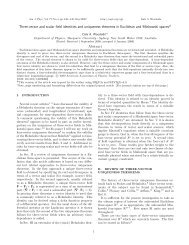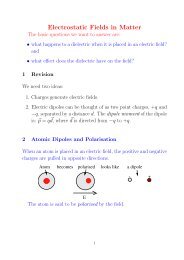<strong>Chapter</strong> 8 <strong>Vector</strong> <strong>Spaces</strong> <strong>in</strong> <strong>Quantum</strong> <strong>Mechanics</strong> 96can be set up. An important example is one <strong>in</strong> which the system consists of a possiblyvariable number of identical particles. One example is a ‘gas’ of photons, all of the samefrequency and polarization. Such a situation is rout<strong>in</strong>ely achieved <strong>in</strong> the laboratory us<strong>in</strong>gsuitably constructed hollow superconduct<strong>in</strong>g metallic cavities designed to support justone mode (i.e. a s<strong>in</strong>gle frequency and polarization) of the electromagnetic field. The stateof the electromagnetic field can then be characterized by the number n of photons <strong>in</strong> thefield which can range from zero to positive <strong>in</strong>f<strong>in</strong>ity, so that the states of the field (knownas number states) can be written |n〉 with n = 0, 1, 2, . . .. The state |0〉 is often referred toas the vacuum state. These states will then constitute a complete, orthonormal set of basisstates (called Fock or number states), i.e.〈n|m〉 = δ nm (8.65)and as n can range up to <strong>in</strong>f<strong>in</strong>ity, the state space for the system will be <strong>in</strong>f<strong>in</strong>ite dimensional.An arbitrary state of the cavity field can be then be written∞∑|ψ〉 = c n |n〉 (8.66)n=0so that |c n | 2 will be the probability of f<strong>in</strong>d<strong>in</strong>g n photons <strong>in</strong> the field. In terms of these basisstates, it is possible to describe the processes <strong>in</strong> which particles are created or destroyed.For <strong>in</strong>stance if there is a s<strong>in</strong>gle atom <strong>in</strong> an excited energy state <strong>in</strong> the cavity, and the cavityis <strong>in</strong> the vacuum state |0〉, then the state of the comb<strong>in</strong>ed atom field system can be written|e, 0〉, where the e <strong>in</strong>dicates that the atom is <strong>in</strong> an excited state. The atom can later lose thisenergy by emitt<strong>in</strong>g it as a photon, so that at some later time the state of the system will bea|e, 0〉 + b|g, 1〉, where now there is the possibility, with probability |b| 2 , of the atom be<strong>in</strong>gfound <strong>in</strong> its ground state, and a photon hav<strong>in</strong>g been created.8.5 General Mathematical Description of a <strong>Quantum</strong> SystemIt was shown <strong>in</strong> preced<strong>in</strong>g Sections that the mathematical description of this sum of probabilityamplitudes admits an <strong>in</strong>terpretation of the state of the system as be<strong>in</strong>g a vector <strong>in</strong>a complex vector space, the state space of the system. It is this mathematical picture thatis summarized here <strong>in</strong> the general case <strong>in</strong>troduced <strong>in</strong> the immediately preced<strong>in</strong>g Section.This idea that the state of a quantum system is to be considered a vector belong<strong>in</strong>g to acomplex vector space, which we have developed here <strong>in</strong> the case of a sp<strong>in</strong> half system,and which has its roots <strong>in</strong> the sum over paths po<strong>in</strong>t of view, is the basis of all of modernquantum mechanics and is used to describe any quantum mechanical system. Belowis a summary of the ma<strong>in</strong> po<strong>in</strong>ts as they are used for a general quantum system whosestate spaces are of arbitrary dimension (<strong>in</strong>clud<strong>in</strong>g state spaces of <strong>in</strong>f<strong>in</strong>ite dimension). Theemphasis here is on the mathematical features of the theory.8.5.1 State SpaceWe have <strong>in</strong>dicated a number of times that <strong>in</strong> quantum mechanics, the state of a physicalsystem is represented by a vector belong<strong>in</strong>g to a complex vector space known as the state
<strong>Chapter</strong> 8 <strong>Vector</strong> <strong>Spaces</strong> <strong>in</strong> <strong>Quantum</strong> <strong>Mechanics</strong> 97space of the system. Here we will give a list of the def<strong>in</strong><strong>in</strong>g conditions of a state space,though we will not be concern<strong>in</strong>g ourselves too much with the formalities. The follow<strong>in</strong>gdef<strong>in</strong>itions and concepts set up the state space of a quantum system.1. Every physical state of a quantum system is specified by a vector called a statevector, ket vector, or sometimes just state and written | . . .〉 where . . . is a labelspecify<strong>in</strong>g the physical <strong>in</strong>formation known about the state. An arbitrary state iswritten |ψ〉, or |φ〉 and so on. The set of all state vectors describ<strong>in</strong>g a given physicalsystem forms a complex vector space (actually a Hilbert space, see Sec. 8.5.2) Halso known as the state space or ket space for the system.2. Every l<strong>in</strong>ear superposition of two or more state vectors |φ 1 〉, |φ 2 〉, |φ 3 〉, . . . , is also astate of the quantum system i.e. the state |ψ〉 given by|ψ〉 = c 1 |φ 1 〉 + c 2 |φ 2 〉 + c 3 |φ 3 〉 + . . .is a state of the system for all complex numbers c 1 , c 2 , c 3 , . . . .These last two po<strong>in</strong>ts amount to say<strong>in</strong>g that every physical state of a system is representedby a vector <strong>in</strong> the state space of the system, and every vector <strong>in</strong> the state space representsa possible physical state of the system. To guarantee this, the follow<strong>in</strong>g condition is alsoimposed:3. If a state of the system is represented by a vector |ψ〉, then the same state is representedby the vector c|ψ〉 where c is any non-zero complex number.F<strong>in</strong>ally, we need the concept of a set of basis states, and of the dimension of the statespace.4. A set of vectors {|ϕ 1 〉, |ϕ 2 〉, |ϕ 3 〉, . . . } is said to form a basis for the state space ifevery state of the quantum system can be represented as a l<strong>in</strong>ear superposition ofthe |ϕ i 〉’s i.e. for any state |ψ〉 we can write∑|ψ〉 = c i |ϕ i 〉.iThe set of vectors {|ϕ i 〉, i = 1, 2, . . . } are said to span the vector space. The vectorsare also termed the base states for the vector space. They are also said to becomplete. What this means, mathematically, is that for every state |φ〉 say, at leastone of the <strong>in</strong>ner products 〈ϕ n |φ〉 will be non-zero, or conversely, there does not exista state |ξ〉 for which 〈ϕ n |ξ〉 = 0 for all the basis states |ϕ n 〉. Completeness clearlymeans that no more basis states are needed to describe any possible physical stateof a system.For example, return<strong>in</strong>g to the sp<strong>in</strong> half system, the two states |±〉 are all that is needed todescribe any state of the system, i.e. there are no sp<strong>in</strong> states that cannot be described <strong>in</strong>terms of these basis states. Thus, these states are said to be complete.
















